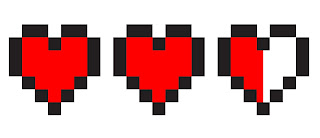So let's start off with the big kahuna. In Dungeons and Dragons, nearly everything has a listed value of hp. A first level character may have around 12 hit points depending on class. As they gain levels, their hp increases, all the way into the hundreds. So, what do the hit points in D&D stand for? Well first we have to look at a few things. A character loses hp when they are hit with damage from an attack. Characters also gain hp when they level up. So, is hp loss is the result of physical wounds, does this mean that a level 5 character can be stabbed in the gut more times than a level 1 character? Logically, this doesn't make much sense. A football player will be taken out just as quickly with a stab to the gut as myself. HP in D&D is an abstract way to track a characters weariness. Damage represents close calls, near misses, and general fatigue that must be endured. That is, until you hit half of your HP. In D&D 4th Edition, characters gained a status called bloodied once they dropped below half of their max hp. This represented a physical hit on a character.
The One Ring RPG takes the idea of hit points and becoming bloodied and turns it into the concepts of endurance and becoming wounded. Characters lose endurance during a fight, and a physical hit is never landed until the character becomes wounded via the TOR equivalent of a critical hit. Being wounded in TOR is much more explicit and difficult to heal compared to endurance. Fate has a similar mechanic, tracking stress and consequences. Fate's consequences mechanic also has the benefit of being useful for social encounters, representing mental knocks and setbacks rather than physical ones.
FFG's Star Wars systems "fixes" this abstract hit point problem by having a stat called wounds. Wounds represent actual physical hits of blaster bolts and lightsabers on a character. This stat can be increased, but not in the same fashion or scale that D&D does. These wounds also lead to critical injuries, which maim and cripple characters. Strain is consumed and drained from characters for more mental and endurance consequences.
So if you're running a game and you want a better understanding of how to narrate combats, take a look at what the hit points in your system represents.
The One Ring RPG takes the idea of hit points and becoming bloodied and turns it into the concepts of endurance and becoming wounded. Characters lose endurance during a fight, and a physical hit is never landed until the character becomes wounded via the TOR equivalent of a critical hit. Being wounded in TOR is much more explicit and difficult to heal compared to endurance. Fate has a similar mechanic, tracking stress and consequences. Fate's consequences mechanic also has the benefit of being useful for social encounters, representing mental knocks and setbacks rather than physical ones.
FFG's Star Wars systems "fixes" this abstract hit point problem by having a stat called wounds. Wounds represent actual physical hits of blaster bolts and lightsabers on a character. This stat can be increased, but not in the same fashion or scale that D&D does. These wounds also lead to critical injuries, which maim and cripple characters. Strain is consumed and drained from characters for more mental and endurance consequences.
So if you're running a game and you want a better understanding of how to narrate combats, take a look at what the hit points in your system represents.


No comments:
Post a Comment